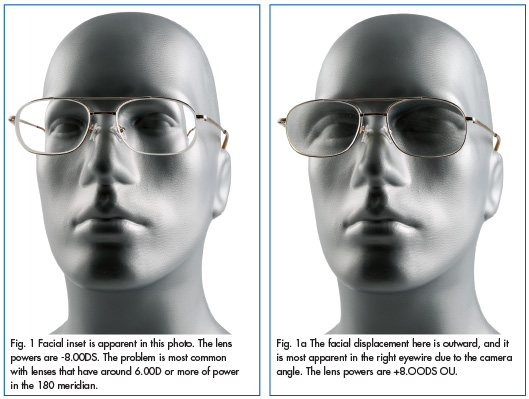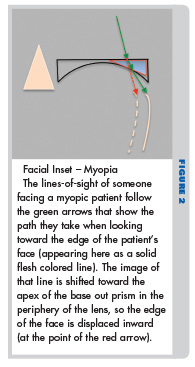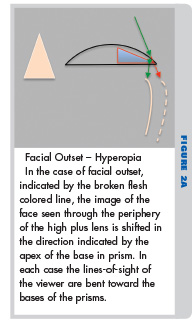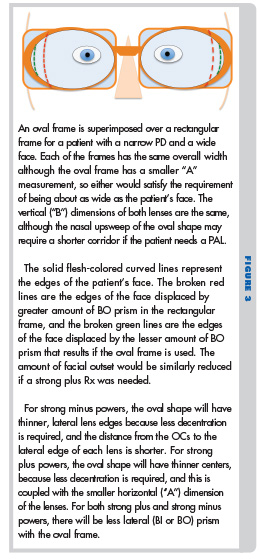
By Palmer R. Cook, OD
Facial Inset and its neighbor, Facial Outset, are appearance challenges as plain as the eyewear on your patients’ faces, and you can help. There was a time when frames with extremely large and square eyewires were all the fashion. Reruns of TV detective/mystery programs of the 1970s such as “McMillan and Wife,” “Baretta,” “Colombo,” “Charlie’s Angels” and “Kojak” are fertile grounds for reviewing this odd period in the history of fashion eyewear. The principals preserved their iconic look by appearing “sans eyewear,” but victims, villains, suspects and bystanders appeared, when eyewear was deemed appropriate, with those oversized specs. It was rare that lenses of stronger powers were used on-camera for reasons we all understand, and this created misunderstandings and disappointment in eyecare providers’ offices.
“That’s just not the frame I selected,” patients would complain during those years when they saw their mid-range and higher lenses in a 54 x 54 mm frame. Today’s higher index materials that reduce edge thickness were simply not available, and patients tended to ignore cautions about appearance and thickness until an epiphany of dismay arose at the time of dispensing. Actually a -6.00 or so in a 54 x 54 frame coupled with a double gradient tint (dark rose or blue at top and bottom and fading downward and upward respectively toward the center was considered chic in those years) could leave patients needing only a cape to resemble the Phantom of the Opera.
Today’s lighter weight, higher index materials coupled with our ability to produce aspheric, digital lenses have eased some of the problems of using large lenses. Yet neither selecting a different material nor using aspheric curvatures can correct the issue of facial displacement, which is primarily a problem for prescriptions in excess of about 6 diopters. Facial displacement for myopic patients means that there is an “inset” of the lateral edge of the face that is cosmetically undesirable (Fig. 1 and Fig. 2). For hyperopic patients an “outset” can occur (Fig. 1a and Fig. 2a).


For a light ray passing through the optical center of a minus lens, there is no prismatic effect. For light rays passing through the lens at any point other than the optical center, the ray will be bent away from the optical center (Fig. 2). That amount of bending can be measured in prism diopters. One prism diopter would deflect the light ray by 1 cm if it intersected a screen 1 meter from the lens. If the lens power is known, it is simple to calculate the prism effect of the lens at any distance from the optical center by multiplying the lens’ power by the distance in centimeters from the optical center.
For example, your patient with a -5.00DS lens will experience 5△ of prism when looking 1 cm away from the optical center. (The symbol for prism diopter is △). If the lens is in front of the right eye, looking to the right through a point 1 cm from the optical center will give 5△ of base out (BO) prism effect. It is called BO because the thickest part of a minus lens is away from the lens center, and that thickest part is outward, away from his nose. Of course, if the line of sight looked 2 cm away from the lens center, the amount of prism would be 10△ according to Prentice’s Law (5.00D x 2 cm = 10△). Excessive decentration due to the patient’s PD being much narrower than the frame PD increases facial inset.
Facial inset occurs due to Base Out prism in the lateral periphery of a lens. When looking at someone wearing minus lenses, your line-of-sight enters into their lens, and it is deflected inward by the BO prism in the outer portion of the lens (Fig. 2). This makes the side of the spectacle wearer’s face to appear to be shifted inward. The result is called facial inset.
The lateral edge of the face is usually about 15 mm behind the apex of the cornea. If the patient’s vertex distance is about 13 mm, and if the frame has no wrap, the distance from the peripheral lens to the side of the patient’s face would fall in the neighborhood of approximately 28 mm behind the lens. It might be a little further back, looking at the person straight on, and perhaps not quite so far back if you are viewing from an angle. The amount of inward displacement is caused by the amount of BO prism at the outer edge of the lens and the distance from the lens to the edge of the face. Using a lens material of higher or lower index will have no significant effect on facial inset. Likewise, using an aspheric lens will not significantly reduce the problem.
The best ways to reduce facial inset are to control the amount of lateral prism at the outer edge of the lens, and to reduce the distance from the back of the lens to the patient’s face. On strong minus lenses, you may achieve a somewhat better result by having the lab roll and polish the lens edges. This will also improve the appearance of the thick lateral edge of the lens.
FACIAL OUTSET
Problems of facial outset (Fig. 2a) are rarer than facial inset. Several years ago, I happened to notice a newscaster/weatherman, on a small local station with an acute case of facial outset. This fellow had a moon-shaped face and a fairly strong plus Rx. His face ballooned to the lateral edges of his lenses. He was a genial sort of guy with a nice presentation personality; perhaps he had failed to heed his optician’s advice. Maybe he thought that by using an overlarge rectangular frame, he would reduce the apparent size of his face. But his plus power, wide frame, narrow PDs and long vertex distance were a combination that yielded an unfavorable outcome. He even had AR lenses, which are particularly important when appearing in front of the cameras, although AR does not improve facial displacement. (All this made me wonder why I couldn’t recall seeing this effect previously. My conclusion is that if it’s possible to do something, someone will do it whether it’s a good idea or not.)
Before low density lens materials were available, people, especially those with strong plus prescriptions, often requested lighter weight glasses. Then poly came along with a density of 1.20 and later Trivex arrived with an even lighter at 1.11, so the weight of strong plus lenses became much less of an issue. One could still have a relalens by using a higher index lens material. Finally, digitally-produced aspheric lenses now allow us to make even thinner lenses. Unfortunately, even with the low density, higher index, thinnest practical lens digital designs, the bottom line, a good cosmetic outcome, is not always achieved.
DECENTRATION
When lenses are produced, your lab places the optical centers (OCs) inward to center them on the pupil. The amount the OC is moved inward from the geometric center of the eyewire is called “decentration.” Keeping lens decentration to a minimum reduces lens weight and thickness. When helping with frame selection, always compare the patient’s monocular PDs with the PDs of the frame under consideration. If the frame is a 52□20 just add the numbers and divide by 2. The result will be the frame’s monocular PD (i.e., [52 +20]/2 = 36). If your patient’s monocular PDs are OD 31, OS 30, (usually written 31/30) then the right lens must be decentered in 5 mm (36 – 31 = 5), and the left lens must be decentered in 6 mm (36 – 30 = 6). A general rule is to achieve a 1, 2 or 3-mm decentration at most. If you are dealing with strong lenses and trying to avoid facial inset (or outset, which occurs with strong plus lenses) the rule is “the less decentration the better.”
TABLE 1:
Predicting Facial Inset and Outset
| Axis | Power/Diopter of Cyl | |
| Decimal | By % | |
| 090 | 1.0000 | 100.00% |
| 085 095 | 0.9924 | 99.2% |
| 080 100 | 0.9698 | 97.0% |
| 075 105 | 0.9330 | 93.3% |
| 070 110 | 0.8830 | 88.3% |
| 065 115 | 0.8214 | 82.1% |
| 060 120 | 0.7500 | 75.0% |
| 055 125 | 0.6710 | 67.1% |
| 050 130 | 0.5868 | 58.7% |
| 045 135 | 0.3290 | 32.9% |
| 040 140 | 0.4132 | 41.3% |
| 035 145 | 0.3290 | 32.9% |
| 030 150 | 0.2500 | 25.0% |
| 025 155 | 0.1786 | 17.9% |
| 020 160 | 0.1170 | 11.7% |
| 015 165 | 0.0670 | 6.7% |
| 010 170 | 0.0302 | 3.0% |
| 005 175 | 0.0076 | 0.8% |
| 180 | 0.0000 | 0.0% |
By knowing the power of the patient's lens in the 180 degree meridian, and the distance from the major reference point to the lateral edge of the lens, you can predict facial inset and outset. For spherical lenses the refractive power in the 180 degree meridian is simply the lens power as written. If the lens has cylinder, use this table to find the amount of lens power the cylinder contributes to the total power in the 180 degree meridian. Ex. -2.00 -3.00 x 060 contributes 75 percent of the total cylinder power to the 180 degree meridian (or -2.25 diopters -3.00 x .75 = 2.25. The sphere power is -2.00, so the total power in the 180 degree meridian is -4.25 diopters. If the distance from the MRP to the lateral edge of the lens is 15 mm (or 1.5cm), the patient would have about 6.37△BO prism (1.5 x 4.25 = 6.375) at the lateral edge of his lens.
*This chart is based on the formula (sine of the axis)2 x the cylinder power equals the power supplied by the cylinder in the 180 meridian.
You can predict the prismatic effect that causes facial displacement if you know the power of the lens in the 180 meridian and the distance from the OC to the outer edge of the lens. To find the power in the 180 meridian for any lens use Table 1. Combine the cylinder power, if any, with the sphere power (Ex. -2.00 -3.00 x 070). Use Table 1 and locate axis 070 to find that an x 070 cylinder will contribute 88.3 percent of its power to the 180 meridian. Multiply 88.3 percent by the power of the cyl (-3.00 x .883 = -2.65) and combine the result with the 0sphere power (-2.00) to find the power in the 180 meridian is -4.65. If the distance from the OC to the outer edge of the lens is 1.8 cm, the patient will have 8.37△BO prism. Holding an 8△BO trial prism at about where the patient’s outer lens margin will be can give you an idea of how much facial inset to expect. (The trial prism should be held with the base outward.)
The advantage of wrap when facial inset (or outset) is concerned lies in the movement of the outer edge of lens closer to the face. As mentioned above, 1△ of prism deflects light 1cm at a distance of 1m, however if the screen were moved to half a meter, the deflection would be cut in half. This principle holds true for making the outer edge of the lens closer to the face, even though from a practical standpoint, the movement would be only a few millimeters closer.
 THE FRAME
THE FRAMEIf you see your patient falling in love with a frame that will require excessive decentration, step in before Cupid’s arrow flies. A firm statement that the frame is not suitable for the prescription should be given. Phrase it however you wish, but optics can be unforgiving, and an unfavorable outcome will reflect upon your whole office. Avoid saying, “Your eyes are set too close together, and you are too nearsighted (or too farsighted) for that frame to work.” Tact and kindness should be used, but you are the professional, and the patient has no way of understanding the issues. It is always the outcome that is long remembered, and that should always be the best one possible for the patient you are helping.
Another frame issue that reduces facial inset and outset is related to lens shape. As a general rule, a rectangular lens shape exacerbates facial inset and outset. By using an oval-shaped frame style (Fig. 3), you are eliminating some, or perhaps much of the lens area that causes the facial displacement.
Even if your patient has a head shaped like a basketball, the overall width of the frame should be about as wide as the patient’s face at its widest point. This is fundamental to achieving the best cosmetic outcome. In these cases, using a frame constructed so that the actual distance between the outermost edges of the lenses is significantly less that the overall width of the frame itself (like the oval frame in Fig. 3) will reduce both facial inset and outset. This is apparent in Fig. 3. Some frames achieve this by using a turnback temple arrangement; others (non-metallic frames usually) use a front with a wider eyewire laterally, and a few combine both techniques. All of this tends to make plus lenses thinner with less unwanted magnification; for minus lenses the edge thickness is reduced. For both plus and minus lenses, the lens volume and therefore the weight, is reduced.
WRAP
Wrap (sometimes called face form) refers to curving the frame to more closely match the natural curvature of the face. It can be cosmetically desirable to use wrap to reduce facial displacement; however this can create a prism effect which should be neutralized and a need for increasing the PDs because the lenses are rotated around a vertical axis and angled closer to the face. An average wrap for most frames is about 6 degrees to 8 degrees. Over 8 to 10 degrees can affect lens performance unless compensations are made. Ask your lab consultants what they recommend as the outer limits of sphere and cylinder power for wrap frames, and respect their recommendation.
SIDESTEPPING THE PROBLEM
Patients with facial displacement issues have all of the other problems related to higher-powered lenses. These include increased chromatic aberration, prism distortion, lens weight and comfort issues, and smaller sweet spots. They may tell you, “I tried contact lenses, but...” Those contact lens-related comments should be given careful attention. If patients’ reasons for avoiding contacts are due to visual performance, they need to know that contact lens technology has improved significantly and should be considered again. A refractive error of -10.00 -425 x 150 with a 2.50 add can offer an overwhelming challenge if contacts alone are used. Using contacts to correct most of the sphere power coupled with an overcorrection in spectacle lenses may give better results than if either contacts alone or glasses alone are used.
OUTCOMES
Appearance is important. How your patients look in their new eyewear can be nearly as important to them as how they see. And to their friends, family and co-workers, the cosmetic outcome may be the primary basis for evaluating your skill and expertise. Facial displacement is primarily a problem for prescriptions in excess of about 6 diopters, but achieving a more attractive appearance for those patients can build great respect and recognition for your practice. ■
Contributing editor Palmer R. Cook, OD, is director of professional education at Diversified Ophthalmics in Cincinnati, Ohio.













